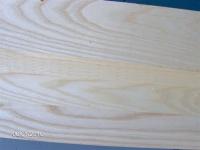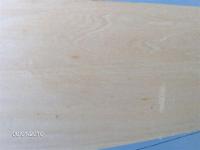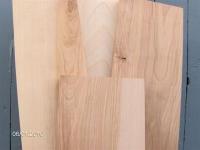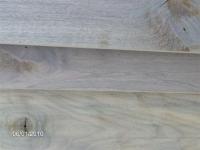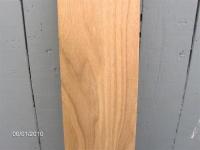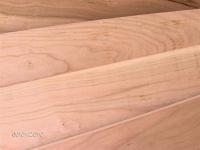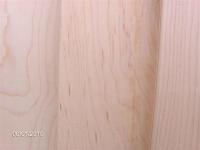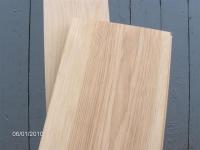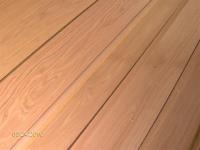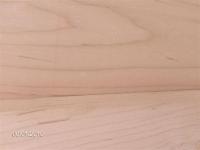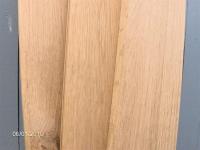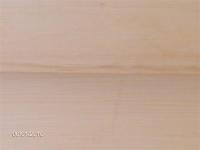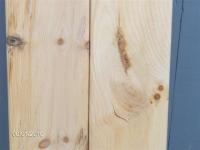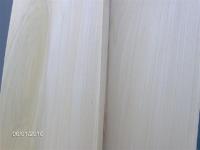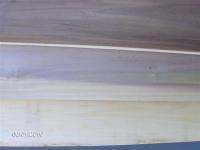
Species
Click on an image to enlarge.
The white ash is also known as American Biltmore or cane ash. Ash has a heartwood which is brown in color, and its sap wood is generally white. This wood is most famous for being the best wood for baseball bats and other sports equipment such as tennis racquets, hockey sticks, polo mallets, and playground structures. The reasons for white ash being the most popular wood for these items is that it is tough and does not break under large amounts of strain. This wood can be bent into different shapes without losing its strength and is quite light. There are numerous other uses for white ash wood including church pews, bowling alley flooring, garden and porch furniture, and cabinets.
Basswood is a desirable wood for carving artifacts, musical instruments, and hunting decoys. Products made from the soft, pale, lightweight, and straight-grained wood include wooden dishware, cabinets, paper, and piano soundboards.
Birch has light yellow sapwood and reddish brown heartwood. Once stained, the color differences are less pronounced. It has straight, close grain and a fine, even texture.
Birch posesses high bending and crushing strength. It has very good steam bending characteristics, and high shock resistance. It works fairly easily with hand and power tools, glues well, and takes stain and polish extremely well.
Walnut is a tough hardwood of medium density, with moderate bending and crushing strengths and low stiffness. It has a good steam-bending classification. Walnut works easily with hand and machine tools, and nails, screws and glues well. It holds paint and stain very well for an exceptional finish and is readily polished.
Black Walnut is often used in furniture, cabinets, architectural millwork, doors, flooring, paneling, and gun stocks. If is a favored wood for using in contrast with lighter-colored species.
Butternut is also known as Oilnut or White Walnut. The light brown, soft, coarse-grained wood works, stains, and finishes well. Small amounts are used for cabinetwork, furniture, paneling, and novelties.
It is native to the eastern United States and southeast Canada, from southern Quebec west to Minnesota, south to northern Alabama and southwest to northern Arkansas. It is absent from most of the Southern United States.
The reddish-brown color of black cherry heartwood resembles mahogany wood and its hard, close-grained characteristics make beautiful furniture, trim, tool handles, veneers, and cabinets.
Black cherry grows in hardwood hammocks and open areas throughout eastern North America. It ranges from southern Canada to central Florida and as far west as North Dakota and eastern Texas.
Hard Maple is a domestic hardwood. The heartwood is reddish-brown to light tan. The sought after sapwood is nearly white. It has a fine uniform texture and is very strong and hard with close grain. Because of it’s strength and stiffness, it ranks as one of the more valuable hardwoods.
This wood is great for all kinds of turnery. Hard Maple works well with sharp tools and adheres well with glue. It must be pre-bored for nails and screws. Hard Maple takes stains and polish well. This tough wood has a tendency to burn during end grain cuts. Hard Maple has many uses. Furniture - flooring - cabinetry - musical instruments - bowling alleys and pins - butcher blocks - dance floors - turnery and plywood.
This wood is a valued lumber. It is a hard and heavy wood. It is used to manufacture handles for different sports equipment, tools, floorings, cabinets, and veneer for furniture. Historically, the wood was made into wooden wheels because it is dense, has bending qualities, and can withstand compression and shock better than most other woods.
Red Oak is probably the most common and widely used North American wood. Its sap is a lighter white color, while its heart wood has pale pink overtones. It is a medium density, open pored, grainy wood. Red Oak is commonly known as a great cabinet quality wood, flooring and other household millwork.
Soft Maple, also known as Red Maple, has a darker colored heart wood, and a whiter, more desired, sap wood. Soft Maple is often used as a substitute for hard maple or stained to resemble other species such as cherry. It's physical and working properties also make it a possible substitute for beech.
Soft Maple is often used for various items including furniture, paneling, flooring and millwork, kitchen cabinets, mouldings, doors, musical instruments, kitchen utensils, toys, sports goods, crates, pallets, furniture framing and turnings.
Other variations of Soft Maple are Ambrosia (wormy) and Curly Maple.
White Oak is a domestic hardwood. This wood is hard, tough and straight grained. The heartwood is grayish brown and the sapwood is nearly white. White Oak figures are more attractive than Red Oak figures and the wood is more durable.
White Oak takes nails and screws well if pilot holes are drilled. The wood glues satisfactorily and takes stains and polishes well. With sharp tools it works well. White Oak is an excellent steam bending wood. White Oak is commonly used for flooring, furniture, boat building, interior joinery, wagon bottoms, thresholds and decorative veneers.
Eastern White Pine (Pinus strobus) is a large pine native to eastern North America, occurring from Newfoundland west to Minnesota and southeastern Manitoba, and south along the Appalachian Mountains to the northern edge of Georgia. It is occasionally known as simply White Pine, Northern White Pine, or Soft Pine. It is also known as Weymouth Pine, especially in Britain. In addition, this tree is known to the Haudenosaunee Native Americans as the Tree of Peace.
White Pine works very easily with most machine or hand tools although turning is only fair. Carves quite well, holds nails and screws well without the need to pre-drill. White Pine glues, paints and also varnishes well. A wood sealer is recommended to prevent a blotchy appearance when staining.
White Pine is soft in weight, light in color, easily machined and glues well, maintains structural integrity with normal moisture content changes and displays remarkable durability.
The sapwood is creamy white and may be streaked, with the heartwood varying from pale yellowish brown to olive green. The green color in the heartwood will tend to darken on exposure to light and turn brown. The wood has a medium to fine texture and is straight-grained; has a comparatively uniform texture.
Poplar is a versatile wood that is easy to machine, plane, turn, glue and bore. It dries easily with minimal movement in performance and has little tendency to split when nailed. It takes and holds paint, enamel and stain exceptionally well.
Liriodendron tulipifera, commonly known as the tulip tree, American tulip tree, tuliptree, tulip poplar or yellow poplar, is the Western Hemisphere representative of the two-species Liriodendron genus and the tallest eastern hardwood. It is native to eastern North America from Southern Ontario and Illinois eastward across southern New England and south to central Florida and Louisiana. It can grow to more than 50 m (165 feet) in virgin cove forests of the Appalachian Mountains, often with no limbs until it reaches 25–30 m (80–100 feet) in height, making it a very valuable timber tree. It is fast-growing, without the common problems of weak wood strength and short lifespan often seen in fast-growing species.
